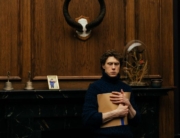Some people make living an art form. This portrait of the artist as an old man follows Bahman Mohassess, an exiled Iranian painter and sculptor, as he attempts to live (and die) according to his own aesthetic.
At first, director Mitra Farahani has to play detective. Mohassess hasn’t been heard from in ages, and many assumed he’s dead. Farahani follows rumors of his whereabouts and finds him in a hotel room in Italy, without quite telling us how. Mohassess seems charmed by the attention of the attractive filmmaker, and he allows her to make what he sees as his film, one more way for him to voice his views.
He certainly has no shortage of them. He says his work is about “the condemnation of existence.” His work features grotesque figures, most missing a combination of arms, feet, eyes, and mouths because he believes multidimensional people no longer exist. He is also fond of paraphrasing a line from Visconti’s The Leopard, that men used to be leopards and lions, but have been replaced by jackals, hyenas, and sheep. Fifi, the film’s titular painting, features an imploded human face. “Howls from happiness,” Mohassess says, as if we couldn’t guess, is ironic.
He has particularly harsh words for his fellow Iranians, “bootlicking” being one of his favorites. The Islamic Revolution made him a controversial figure, and some of his public works were destroyed. While some details of his post-Iran career are unclear, it appears he has continued making art for decades, but that most of it has been destroyed, or as he calls it, deceased. Presumably he did much of the destruction himself. Creating the work is what fulfills him, not seeing it exhibited. He dismisses “immortality and all that nonsense,” claiming he “did not work for posterity.”
Yet like many artists, he contradicts himself. In his hotel room, he displays “a few wounded works struggling not to drown,” and when Farahani finds a pair of Iranian artists who want to purchase them, Mohassess is perfectly willing to tally up a price. And when these potential buyers, brothers Rokni and Ramin Haerizadeh, ask him questions about his work, he cheerfully prattles on, though earlier he had snapped at Farahani’s attempt to interpret his art: “Analyzing everything in life is stupid.”
All of his bitter rhetoric—softened though it is in old age by his contagious laugh and elfin grin—may rest on nothing more than moodiness. Rokni Haerizadeh puts it best: “He is sulking with the world,” he says, though he hasn’t the courage to repeat it when Mohassess asks him to speak up.
The Haerizadehs eagerly commission him to paint a final opus, and the last third of the film tracks his race against waning health to finish it. Farahani cleverly and meaningfully compares this last movement of his life to a short story by Balzac, “The Unfinished Masterpiece.” With similar thoughtfulness throughout, she has created an elegantly structured and well-crafted documentary to interest the most casual of fine art fans.
In speaking to the Haerizadehs, Mohassess talks of the deaths of Picasso and Dali. They each, according to legend, uttered famous and fitting last words. Mohassess comes very close to such poetry, until reality mars the canvas of his final moments. “I am dying,” he says, and the coughing and hacking becomes too awful to listen to. Ultimately, while he dismisses designs on immortality, he also dictates exactly how he wants his film to end. Farahani grants his wishes, but the age-old question remains. Which is more strange, more wonderful, more true: the man’s art or the man’s life?







Leave A Comment